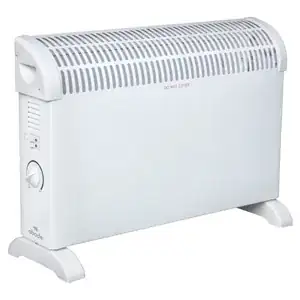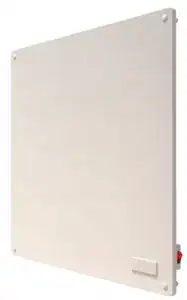Short answer: No.
Long answer: A heater is about as efficient as you can possibly get for an electrical device. Almost 100% of the input energy that goes in is converted to heat[1]. For a newer heater to be 50% more efficient, it would have to use about 67% of the energy to give the same heat - which is difficult, because the original heater is already 100% efficient, so this new one would have to be 150% efficient.
Ceramic materials are very good electrical insulators and have excellent thermal conductivity. The only difference between his ceramic heater and your normal electric heater is the element is probably wrapped around a ceramic core and this then heats up the outer plate, whereas yours just has elements and relies on natural convection to circulate and spread the heat.
Both will be equally efficient at providing heat energy, but they provide it in different ways. Maybe the heat plate is better for heating up one part of a room, but the convection heater is good for the whole room, for example. If you were only using one part of the room, then it would be less efficient to heat up all of it.
There are heating systems that are more than 100% efficient - they are known as heat pumps. They are typically in excess of 300% efficient. However, a heat pump would require an external connection to outside the building to work, as it works by using the thermal energy from outside (and electricity is only drawn to move the heat one way.) And, they are very expensive.
- http://www.conservingelectricity.com/ElectricSpaceHeaters.asp

